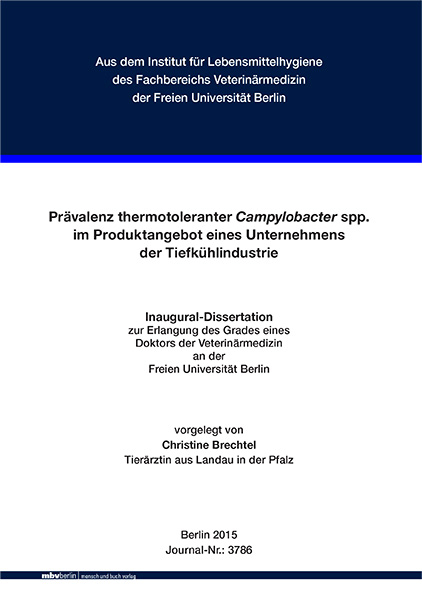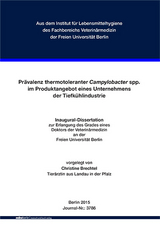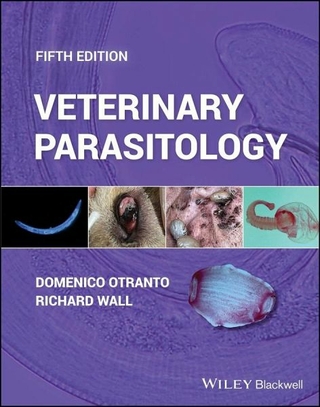Prävalenz thermotoleranter Campylobacter spp. im Produktangebot eines Unternehmens der Tiefkühlindustrie
Seiten
2015
|
1. Aufl.
Mensch & Buch (Verlag)
978-3-86387-619-7 (ISBN)
Mensch & Buch (Verlag)
978-3-86387-619-7 (ISBN)
- Keine Verlagsinformationen verfügbar
- Artikel merken
Prevalence of thermotolerant Campylobacter species in the product range of a company of the frozen food industry
Thermotolerant Campylobacter species are the most common bacterial cause of gastroenteritis. The humane campylobacteriosis is on the top of the notifiable bacterial infectious diseases in Germany with a permanentely increasing number of cases. The infection is predominantely associated with foodstuffs. Poultry meat and poultry products are providing the main risk factors.
The main objective of this study was to determine prevalence of thermotolerant Campylobacter species in the product range of a frozen food distributor using a risk biased sampling plan.
200 frozen food products were tested, 35% of the samples werde raw poultry meat, 35% cooked poultry meat and poultry meat products, 20% other meat and 10% of the samples were products of the rest product range. The investigation was implemented by using a cultural method (ISO 10272:1995) and simultaneously a molecular biological method (pg30/50 PCR-System by OYOFO et al. (1992).
Using the cultural method Campylobacter species were detected in 11 out of 70 samples of the product group „Raw poultry meat“, which leads to an overall prevalence of 15,7%. All cultivated species were detected in two different products ('Chicken breast, unbreaded' and 'Whole chicken legs') which lead to an isolation rate of 24,4% out of that product group (n=45) while the two other raw chicken products ('Chicken breast, breaded' and 'Chicken breast, marinated') and the turkey products ('Turkey schnitzel' and 'Turkey barbecue steaks, marinated') and all samples from the other product groups were free of Campylobacter contamination.
The prevalence of Campylobacter related to the total number of samples (n=200) amounted to 5,5%. The strategic approach to use a risk based sample plan was confirmed by the results of the study.
The species characterization identified 8 isolates as C. jejuni (73%) and 3 isolates as C. coli. The PCR-System by OYOFO does not enable a differentiation between C. jejuni and C. coli. Proof of specific gen sequenzes of C. jejuni/C. coli were succeded in 11 cases and matched the results of the cultural method with a sensitivity and a specificity of 100%.
Thermoterante Campylobacter spp. sind die häufigsten Erreger bakterieller Gastroenteritiden und die humane Campylobacteriose steht mit stetig steigenden Fallzahlen an der Spitze der meldepflichtigen bakteriellen Infektionskrankheiten in Deutschland. Die Übertragung ist weitgehend Lebensmittel-assoziiert, mit Geflügelfleisch und Geflügelfleischprodukten als Hauptrisikofaktor.
Ziel der vorliegenden Arbeit war die Ermittlung der Prävalenz thermotoleranter Campylobacter spp. im Gesamtsortiment eines Tiefkühlkostvertriebes anhand eines risikiobasierten Stichprobenplanes. Zur Untersuchung gelangten insgesamt 200 tiefgekühlte Lebensmittelproben, davon entfielen 35% der Proben auf rohes Geflügelfleisch, 35% auf gegartes Geflügelfleisch und Geflügelfleischprodukte, 20 % auf sonstiges Fleisch und 10% auf das Restsortiment.
Die Untersuchung erfolgte mit der kulturellen Nachweismethode nach ISO 10272:1995 und parallel dazu molekularbiologisch mit dem pg30/pg50 PCR-System nach OYOFO et al. (1992).
Mit der kulturellen Nachweismethode konnten in 11 von 70 Proben der Produktgruppe „Geflügelfleisch roh“ Campylobacter spp. nachgewiesen werden, was einer Isolierungsrate von 15,7% entspricht. Alle kultivierten Stämme wurden in zwei verschiedenen Produkten (Hähnchenbrustfilet, unpaniert und Ganze Schenkel vom Hähnchen) aus rohem Hähnchenfleisch detektiert, woraus sich eine Isolierungsrate von 24,4% bezogen auf diese Gruppe (n= 45) ergibt.
Die zwei übrigen rohen Hähnchenfleischprodukte (Hähnchen-Brustfilet, paniert und Hähnchen-Brustfilet, gewürzt) sowie die Produkte aus rohem Putenfleisch (Truthahn-Schnitzel und Truthahn-Grillsteaks. mariniert) und alle übrigen Proben des restlichen Sortiments erwiesen sich als Campylobacter-frei. Die Campylobacter-Prävalenz bezogen auf die Gesamtprobenanzahl (n = 200) betrug somit 5,5%. Der strategische Ansatz des risikobasierten Stichprobenplans wurde durch die Untersuchungsergebnisse bestätigt. Bei der Speziesdifferenzierung konnten 8 Stämme als C. jejuni (73%) und 3 Stämme als C. coli (27%) identifiziert werden.
Das verwendete PCR-System nach OYOFO unterscheidet nicht zwischen C. jejuni und C. coli. Der Nachweis spezifischer Gensequenzen von C. jejuni/C. coli gelang ebenfalls bei 11 Proben und stimmte mit dem Ergebnis des kulturellen Verfahrens überein, was einer Sensitivität und Spezifität von jeweils 100% entspricht.
Thermotolerant Campylobacter species are the most common bacterial cause of gastroenteritis. The humane campylobacteriosis is on the top of the notifiable bacterial infectious diseases in Germany with a permanentely increasing number of cases. The infection is predominantely associated with foodstuffs. Poultry meat and poultry products are providing the main risk factors.
The main objective of this study was to determine prevalence of thermotolerant Campylobacter species in the product range of a frozen food distributor using a risk biased sampling plan.
200 frozen food products were tested, 35% of the samples werde raw poultry meat, 35% cooked poultry meat and poultry meat products, 20% other meat and 10% of the samples were products of the rest product range. The investigation was implemented by using a cultural method (ISO 10272:1995) and simultaneously a molecular biological method (pg30/50 PCR-System by OYOFO et al. (1992).
Using the cultural method Campylobacter species were detected in 11 out of 70 samples of the product group „Raw poultry meat“, which leads to an overall prevalence of 15,7%. All cultivated species were detected in two different products ('Chicken breast, unbreaded' and 'Whole chicken legs') which lead to an isolation rate of 24,4% out of that product group (n=45) while the two other raw chicken products ('Chicken breast, breaded' and 'Chicken breast, marinated') and the turkey products ('Turkey schnitzel' and 'Turkey barbecue steaks, marinated') and all samples from the other product groups were free of Campylobacter contamination.
The prevalence of Campylobacter related to the total number of samples (n=200) amounted to 5,5%. The strategic approach to use a risk based sample plan was confirmed by the results of the study.
The species characterization identified 8 isolates as C. jejuni (73%) and 3 isolates as C. coli. The PCR-System by OYOFO does not enable a differentiation between C. jejuni and C. coli. Proof of specific gen sequenzes of C. jejuni/C. coli were succeded in 11 cases and matched the results of the cultural method with a sensitivity and a specificity of 100%.
Thermoterante Campylobacter spp. sind die häufigsten Erreger bakterieller Gastroenteritiden und die humane Campylobacteriose steht mit stetig steigenden Fallzahlen an der Spitze der meldepflichtigen bakteriellen Infektionskrankheiten in Deutschland. Die Übertragung ist weitgehend Lebensmittel-assoziiert, mit Geflügelfleisch und Geflügelfleischprodukten als Hauptrisikofaktor.
Ziel der vorliegenden Arbeit war die Ermittlung der Prävalenz thermotoleranter Campylobacter spp. im Gesamtsortiment eines Tiefkühlkostvertriebes anhand eines risikiobasierten Stichprobenplanes. Zur Untersuchung gelangten insgesamt 200 tiefgekühlte Lebensmittelproben, davon entfielen 35% der Proben auf rohes Geflügelfleisch, 35% auf gegartes Geflügelfleisch und Geflügelfleischprodukte, 20 % auf sonstiges Fleisch und 10% auf das Restsortiment.
Die Untersuchung erfolgte mit der kulturellen Nachweismethode nach ISO 10272:1995 und parallel dazu molekularbiologisch mit dem pg30/pg50 PCR-System nach OYOFO et al. (1992).
Mit der kulturellen Nachweismethode konnten in 11 von 70 Proben der Produktgruppe „Geflügelfleisch roh“ Campylobacter spp. nachgewiesen werden, was einer Isolierungsrate von 15,7% entspricht. Alle kultivierten Stämme wurden in zwei verschiedenen Produkten (Hähnchenbrustfilet, unpaniert und Ganze Schenkel vom Hähnchen) aus rohem Hähnchenfleisch detektiert, woraus sich eine Isolierungsrate von 24,4% bezogen auf diese Gruppe (n= 45) ergibt.
Die zwei übrigen rohen Hähnchenfleischprodukte (Hähnchen-Brustfilet, paniert und Hähnchen-Brustfilet, gewürzt) sowie die Produkte aus rohem Putenfleisch (Truthahn-Schnitzel und Truthahn-Grillsteaks. mariniert) und alle übrigen Proben des restlichen Sortiments erwiesen sich als Campylobacter-frei. Die Campylobacter-Prävalenz bezogen auf die Gesamtprobenanzahl (n = 200) betrug somit 5,5%. Der strategische Ansatz des risikobasierten Stichprobenplans wurde durch die Untersuchungsergebnisse bestätigt. Bei der Speziesdifferenzierung konnten 8 Stämme als C. jejuni (73%) und 3 Stämme als C. coli (27%) identifiziert werden.
Das verwendete PCR-System nach OYOFO unterscheidet nicht zwischen C. jejuni und C. coli. Der Nachweis spezifischer Gensequenzen von C. jejuni/C. coli gelang ebenfalls bei 11 Proben und stimmte mit dem Ergebnis des kulturellen Verfahrens überein, was einer Sensitivität und Spezifität von jeweils 100% entspricht.
| Erscheinungsdatum | 23.06.2017 |
|---|---|
| Verlagsort | Berlin |
| Sprache | deutsch |
| Maße | 148 x 210 mm |
| Einbandart | gebunden |
| Themenwelt | Veterinärmedizin ► Klinische Fächer ► Parasitologie |
| Schlagworte | Campylobacter coli • Campylobacter jejuni • Campylobacter spp. • cultural methods • Food Safety • Lebensmittelhygiene • Polymerase chain reaction • poultry meat • Prevalence • Public Health • Tiefkühlindustrie |
| ISBN-10 | 3-86387-619-9 / 3863876199 |
| ISBN-13 | 978-3-86387-619-7 / 9783863876197 |
| Zustand | Neuware |
| Informationen gemäß Produktsicherheitsverordnung (GPSR) | |
| Haben Sie eine Frage zum Produkt? |
Mehr entdecken
aus dem Bereich
aus dem Bereich
Buch | Spiralbindung (2023)
Schlütersche (Verlag)
179,00 €




